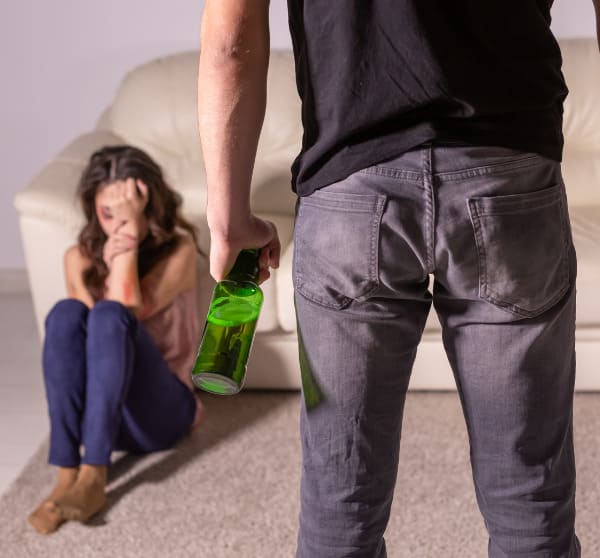WHAT CAN YOU DO IN CASE OF FAMILY VIOLENCE?
Article 15 of the Political Constitution of the Plurinational State of Bolivia establishes in its first and second paragraphs that: “I. Every person has the right to life and to physical, psychological, and sexual integrity. II. All people, especially women, have the right not to suffer physical, sexual, or psychological violence, whether within the family or in society.” In response to the increasing number of violence cases against women, in 2013 Bolivia enacted the Comprehensive Law to Guarantee Women a Life Free from Violence (Law No. 348), which establishes mechanisms for prevention, protection, assistance, reparation, and punishment for perpetrators.
According to Article 272 bis of Law No. 348, domestic or family violence is defined as any form of physical, psychological, or sexual aggression committed by a family member, spouse, partner, co-parent, or any person with whom the victim has or had an emotional or intimate relationship, regardless of cohabitation. It also includes those in a caregiving or authority role within the household. Offenders may face prison sentences ranging from two to four years, unless the act constitutes another criminal offense.
WHERE TO REPORT DOMESTIC OR FAMILY VIOLENCE?
Since domestic or family violence is considered a criminal offense, it must be reported to the proper authorities. Articles 284 to 289 of the Criminal Procedure Code (CPC) state that complaints may be submitted verbally or in writing to the Public Prosecutor’s Office (Specialized Prosecutor’s Office for Priority Victims – FEVAP) or to the police (Special Force to Combat Violence – FELCV, Article 42 of Law No. 348). In areas where these authorities are unavailable, the complaint may be submitted to a sub-prefect or corregidor, who must then notify the nearest prosecutor.
For verbal complaints, legal representation is not required. However, for written complaints, a formal complaint brief must be submitted to the prosecutor’s office, prepared by a licensed attorney.
WHERE TO SEEK SUPPORT TO FILE A DOMESTIC VIOLENCE REPORT?
Before filing a report, victims may approach organizations that encourage reporting, such as the Municipal Comprehensive Legal Services (SLIMS) if the victim is an adult, or the Child and Adolescent Defense Offices (DNAs) if the victim is a minor. These entities provide psychosocial assessments and, based on the outcome, may support the filing of a verbal or written report with the police or Public Prosecutor’s Office (Article 50 of Law No. 348 and Article 188 of Law No. 548). Victims may also seek assistance from the Plurinational Integrated Justice Services, the Plurinational Victim Defense Service, or Indigenous Community Authorities, as applicable (Article 42 of Law No. 348).
WHAT TO DO IN CASE OF FLAGRANT ACTS OF VIOLENCE?
In cases of flagrancy—when the perpetrator is caught committing the crime or immediately after while being pursued by law enforcement, the victim, or witnesses—an immediate arrest can be made by the police or even by a private individual, who must then promptly hand over the perpetrator to the appropriate authorities (Articles 227 to 230 CPC).
Additionally, direct action can be initiated by calling the police, who are required to intervene, assist the victim, secure the crime scene and any evidence, and proceed with the arrest of the aggressor or detain suspects (Articles 225, 227, 293 to 295 CPC).
HOW TO PROCEED WHEN THE VICTIM SUFFERS INJURIES?

HOW DO PROTECTIVE MEASURES WORK IN FAMILY VIOLENCE CASES?
Immediately upon receiving the complaint, the prosecutor will determine protective measures to safeguard the life, physical, psychological, and sexual integrity, as well as the economic, labor, and property rights of the victim and their dependents.
According to Article 35 of Law No. 348, protective measures may include restraining orders, family support orders, return of the victim to their home, prohibition of communication or intimidation, suspension of visitation rights, inventories and prohibition on the disposal of joint assets, return of personal items and documents, workplace flexibility, and any other measures necessary to ensure the victim’s safety.
These protective measures must be validated by a judge, who may also impose special protection measures for children, adolescents, or women experiencing violence, in accordance with Article 389 bis CPC. Protective measures remain in effect as long as the conditions that led to their imposition persist, regardless of the stage of the criminal process (Article 389 quater CPC).
If the measures are violated, this must be immediately reported to the competent authority. The prosecutor may refer the victim to the Victim and Witness Protection Unit (UPAVT). In the event of a violation of special protective measures ordered by the judge, the court may impose preventive detention on the aggressor for a period of three (3) to six (6) days depending on the severity (Article 389 quinquies CPC).
IS RECONCILIATION ALLOWED IN CASES OF DOMESTIC VIOLENCE?
Article 46 of Law No. 348 strictly prohibits reconciliation in any case of violence against women that endangers their life or sexual integrity. Exceptionally, and only in cases not covered by the aforementioned clause, reconciliation may be pursued voluntarily and without coercion by the victim, only once, and is not allowed in cases of repeat offenses.
WHAT DOES THE CRIMINAL PROCESS FOR DOMESTIC VIOLENCE INVOLVE?
Once a complaint is filed, the criminal process begins and, under Article 133 of the CPC, must conclude within a maximum of three years. The public prosecutor conducts the investigation independently, with or without the participation of the victim (Articles 59, 61, 94 of Law No. 348), supported by FELCV investigators (Article 53 Law No. 348; Articles 277, 278 CPC), with whom the investigation strategy is coordinated (Article 69 CPC).
Throughout the criminal proceedings, both parties may request investigative actions, and various forms of evidence—documentary, testimonial, expert, and physical—will be gathered to determine the truth (Articles 171, 172 CPC; Articles 93 to 95 of Law No. 348). Revictimization must be avoided (Articles 61, 393 octer of Law No. 348), and proper access to justice must be ensured (Article 115 of the Constitution).
CONCLUSION
Domestic and family violence can manifest in various forms and leave both short- and long-term consequences. Victims often suffer pain, trauma, and social isolation, and may be afraid to seek help for themselves and their loved ones. It is essential to take preventive and protective measures and break the cycle of violence by ensuring the safety and integrity of the victims. Knowing where and how to report these acts is key to receiving comprehensive support and timely protection.
If you believe you need legal advice after reading this article, don’t hesitate to contact one of our specialized attorneys. We are here to support you.
Frequently Asked Questions (FAQs)
Can I report domestic violence without a lawyer?
Yes. Verbal complaints can be filed without legal representation. However, written complaints submitted to the Prosecutor’s Office must be prepared by a licensed attorney.
What institutions provide initial support before filing a complaint?
Victims can approach SLIMS (Municipal Legal Services) if they are adults, or DNAs (Child and Adolescent Defense Offices) for minors. These services offer psychosocial evaluations and help facilitate the reporting process.
What happens if the aggressor violates protective measures?
Violations should be immediately reported. The judge may order the preventive detention of the offender for up to six days, depending on the severity, to ensure the victim’s protection.
Is reconciliation possible in cases of domestic violence?
Reconciliation is strictly prohibited in cases that endanger the victim’s life or sexual integrity. In other cases, it may only occur once and must be initiated voluntarily by the victim, without coercion, and not in cases of repeat offenses.
How long does the criminal process take?
By law, the criminal process for domestic or family violence must conclude within a maximum of three years.
- Ayllón, V. (2014). Violencia contra la mujer y feminicidio en Bolivia. Reporte Estadístico 2012-2013. La Paz, Bolivia: CIDEM.
- Buvinic, M., Morrison, A., y Shifter, M. (1999). “La violencia en las Américas; marco de acción”. En El costo del silencio. Violencia doméstica en las Américas. Washington: BID.
- Centro de Promoción Gregoria Apaza (2014). Modelos de Intervención del Servicio Integral a Mujeres que viven en situación de violencia en el marco de la Ley N° 348. El Alto, Bolivia: CPGA.
- Constitución Política del Estado Plurinacional de Bolivia de 2009. Gaceta Oficial de Bolivia.
- Ley Integral para garantizar a las Mujeres una vida libre de violencia, Ley N° 348 de 03 de mayo de 2013. Gaceta Oficial de Bolivia.
- Ley 1173 de Abreviación Procesal Penal y de Fortalecimiento de la Lucha Integral Contra la Violencia a Niñas, Niños, Adolescentes y Mujeres de 03 de mayo de 2019. Gaceta Oficial de Bolivia.
- Ley 1970 Código de Procedimiento Penal de 25 de marzo de 1999. Gaceta Oficial de Bolivia.
The content of this article does not reflect the technical opinion of Rigoberto Paredes & Associates and should not be considered a substitute for legal advice. The information presented herein corresponds to the date of publication and may be outdated at the time of reading. Rigoberto Paredes & Associates assumes no responsibility for keeping the information in this article up to date, as legal regulations may change over time.




